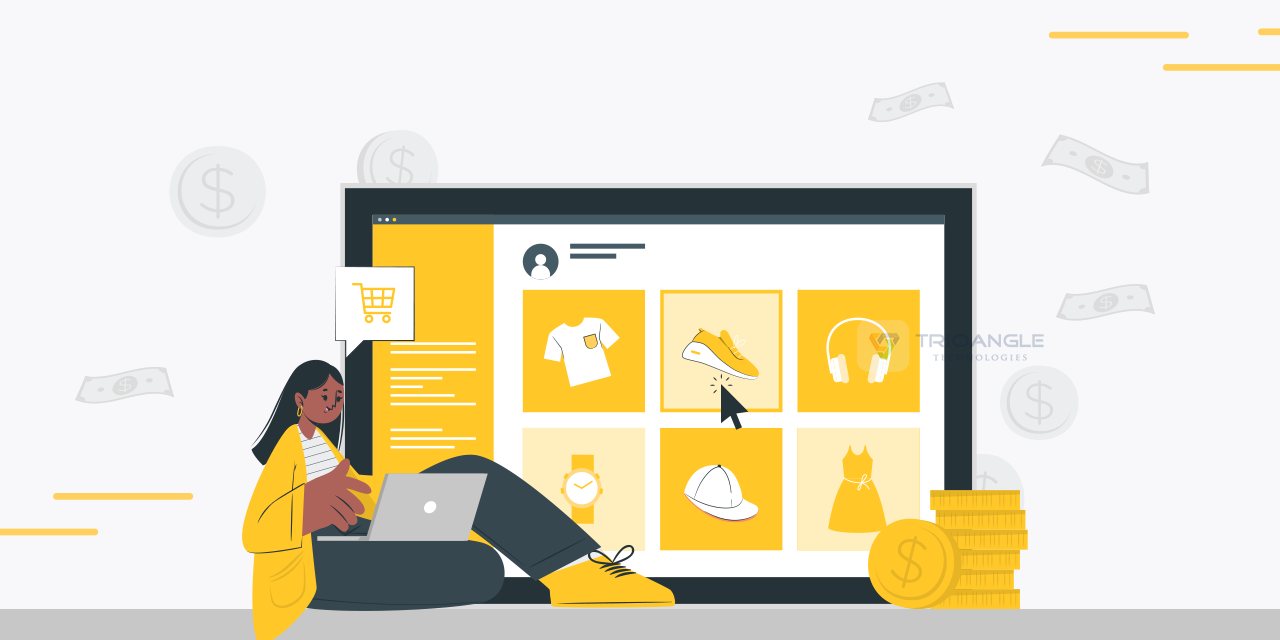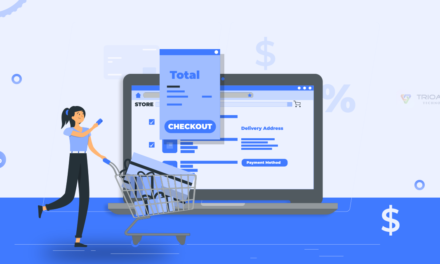Are you interested in launching an Ecommerce business?
Exciting! Your choice is excellent to make a better venture in the forthcoming years. Ecommerce business is a terrific option for individuals aiming to make revenue in the era with less cost.
The latest statistical report shows that the Ecommerce industry reached about 37% of enhancements over the period between 2020-2023. Surely, this growth figure would increase to 62% in the next five years.
Let’s be inclined to bring your new business thought to this rich domain and generate billions in a short period.
Okay, drag on to your vision straight, as an entrepreneur, your first thinking in starting an Ecommerce business would be the cost. Surely, you might have the question “How much does it cost to start launching an Ecommerce business?”
This is the exact blog for you to understand the factors involved in cost decision-making.
Keep reading on…
Cost Of An Ecommerce Business- How To Determine? 🤔
You can start an Ecommerce even with 100 dollars. But, It all depends on your planning.
Thinking, like it is so silly.
Yes, I don’t know if you are planning for an Ecommerce store or marketplace.
These two will come under the category of Ecommerce startup costs. So, have a clear configuration of your startup, if you are focusing on running multi-vendor stores then create a marketplace. Otherwise, you can go with a single vendor or that could be with your manufacturing.
First, you should have a clear comprehension of the bare necessities of an Ecommerce business and start to work on it soon.
Here I have divided the basic requirements of an Ecommerce startup into three phases for your easy understanding,
- Merchandise And Operational Costs
- Legal Considerations
- Ecommerce Website Development
In this article, we are going to have a detailed breakdown of these three phases.
1. Merchandise And Operational Costs
Merchandise and operations are the factors that cause you to big investments. These two expenses are associated with all the managing and operational costs including from inventory to shipping.
But these two costs seriously depend on the Ecommerce business model you choose, which can be a buying inventory or a dropshipping model.
Let’s see in detail.
Dropshipping
It is a business model, in which you don’t need to keep the products in stock, where your retailer could take responsibility for it. In this model, your retailer can act as an intermediary from shipping the products to delivering them to the consumers, you can start your Ecommerce business without any costs of inventory storage or handling of the physical goods.
Buying Inventory
As the name implies you are going to take charge of the inventory, that is from packaging, and shipping to delivery. In this, you could invest costs for maintaining and managing your inventory.
The buying inventory merchandise model involves the following expenditures,
Shipping costs: This is the cost that requires the cost to ship the inventory from the supplier to their warehouses. It includes transportation fees, customs duties, and other associated shipping costs.
Storage costs: It is the costs needed for the space to store your inventory until it’s sold. It includes rent or lease payments for the space and the expenses for maintenance and stored goods.
Inventory management costs: The costs include the software and technology used to track the stock levels, costs related to quality control, and audits.
Supplier Fee: this is the commission to the supplier for the successful delivery to the end users. This commission cost would impact the overall cost of acquiring the entire inventory.
Loss or Obsolescence Costs: This is the expense that is required for the damaged products during shipping and delivery.
These are some of the major costs involved in the merchandise part of the Ecommerce business. So, have a precise plan to handle these costs in the right manner.
Costs Involved In Operations
Operational costs are the ongoing expenses that are required to run your Ecommerce business day by day. These costs are the most essential for the uninterrupted function of your startup, to make it smoother you should work on making your Ecommerce profit in multiple ways.
Let’s see the cost factors of the Ecommerce business operation.
Staffing: Surely, you should have employees to function all the processes. So, this part includes the wages and benefits for the employees who take on various tasks for the seamless business process.
Returns And Refunds: This costs associates to retain your Ecommerce brand name, which includes the fee for returns, refunds, and exchanges. The fee like restocking and return shipping are also considered under this factor.
Packaging And Shipping Supplies: The expenses for packaging materials, boxes, labels, and costs for other supplies to ship the products to consumers.
These are some of the significant operation costs involved in the buying inventory model. As a business owner, you should analyze the factors causing the expenditures, and try to meet the cost-saving opportunities. Focus on optimizing your operations without compromising excellent customer service, which will increase your profitability automatically.
Let’s get into the second phase of the costs required for legalization.
2. Legalization Costs In Ecommerce Business
You are going to sell goods online, so, it is necessary to possess the licenses, permits, and insurance to make your Ecommerce business legal. Generally, these legal costs for an Ecommerce platform comply with the laws, regulations, and licenses based on the country’s governance. Hence, the cost will also differ based on the business localities.
Registration cost
The cost required for registering your business with the appropriate government authorities. This includes your proprietorship like sole, LLC, Corporation, or other legal structure. To avoid paying high these fees, it is advisable to have a consultation with the right professionals.
Fee For Licenses
Licenses are the important meteor to make your business highly legalized. For an Ecommerce business, it is essential to obtain business licenses and permits at the local, state, and federal levels. So, have your fund collection for licensing, which is also based on your location.
Tax Compliance
In many countries, there are different types of taxes applied to the businesses, that accords to the applicable laws based on the startup needs. These tax charges would include the software and its services that handle the sales tax calculations and fillings.
Legal Consultation Involved In Ecommerce Business
Have a legal consultation with the professionals about the legalization matters in the Ecommerce businesses. This consultation would cause you some expenses or you can progress your business regulations further with those legalization agencies.
International Trade And Export Compliance
Surely, your Ecommerce business would involve international trade and export processes. So, having a defined license will assist in avoiding the issues while doing global trade. This license would consume a special cost.
Insurance
One of the significant cost parts, that will expense you more is insurance. There are multiple types of insurance involved in Ecommerce businesses, such as
- General liability insurance for property damage and personal injuries.
- Product liability insurance for the physical goods handling under your services.
- Cybersecurity insurance for protecting against data breaches, and cyber attacks.
- Inventory insurance covers the value of your inventory which replaces the lost or damaged inventory.
- Shipping insurance covers the goods during transit to safeguard them in cases of damage, theft, or loss.
With these insurance types, you can cover your Ecommerce business with the required insurance coverage that your business initially needs. You can add the insurances later as well as your Ecommerce business grows.
From the above legalization costs, you can understand the different parts of expenses involved in the Ecommerce business. Let’s make your business investment plan with the consideration of these funds.
3. Cost For Ecommerce Website Development
The cost of Ecommerce web development can vary from one to another because it widely depends on several factors. Here I’ve listed some core factors that cause big consumption in Ecommerce website development.
Platform Cost In Ecommerce Business
Ecommerce website development involves highly with the Platform cost. So, initially decide your platform.
There are various types of platforms involved in Ecommerce web development. They are,
Magento-creating an Ecommerce site with the Magento platform would consume higher development costs but gives excellent flexibility and scalability to integrate your business ideas.
The WooCommerce platform is a cost-effective way, to develop your Ecommerce site, that gives you a monthly subscription option, for the integration of new features.
Shopify platform also gives various options for launching an Ecommerce website, it has many unique options in the feature integrations, subscriptions, and multiple factors for WordPress users.
Let’s choose your platform based on the expenses that fit your budget.
Design And Customization
Your Ecommerce website designs and customization also make heavy investments in the development process.
If you choose the basic templates and the themes, then it will affordably cost you. Your custom designs and branding can increase the costs accordingly. Also, the responsive designs for dynamic devices add to the cost of website development.
Complexity Of The Website/App
Developing an eCommerce app involves dealing with a myriad of complexities, because of the combination of various functionalities integrated into the app’s work model.
To say clearly, users are expecting more in the shopping apps compared to others like security concerns and integration challenges.
Here I’ve listed some of the important complexities in Ecommerce app development.
User Experience
You should create an appealing user interface that ensures a positive shopping experience. Designing the Ecommerce website with a responsive design for seamless navigation across all devices.
Product Management
Your Ecommerce apps should handle the large and dynamic product catalog. Lagging in this part would cause more issues for the buyers and the vendors. So, create this part with multiple categories and attributes and implement effective search and filtering options for the users.
Shopping Cart And Checkout Process
It is one of the crucial parts, where many of the Ecommerce apps could be more feasible while making the last execution. Implement your app with a smooth and secure checkout process, that includes order management, shipping, and tax calculations accurately.
Payment Gateway Integrations
Integrating various payment methods is a complex part of Ecommerce app development, considering different currencies and regional payment preferences. Also, you should ensure compliance with Payment Card Industry Data Security for secure transactions.
Personalization Algorithms
Sending personalized suggestions to users based on their behavior and preferences is a crucial feature of Ecommerce app development. Balancing personalization with user privacy concerns is a cost-making part.
Along with these significant feature integrations, you should also think about the developer’s location. Because, each region has a particular price value, based on the hourly rate or package rate.
However, give extra concentration to these factors and understand how these features are creating additional costs in your Ecommerce app development.
Ongoing Costs In Ecommerce Business
Apart from the Ecommerce app development, you should know the ongoing costs involved in post-launching of the app.
Some of the important ongoing costs are mentioned here,
Marketing and Advertising
The investment you need to do the offline and online advertising, which includes social media marketing, and SEO that seriously drive traffic to your Ecommerce platform.
Payment Processing
For functioning the right payment transactions, you would integrate third-party payment gateway providers. You should allocate a separate fee amount for processing those transactions securely. This includes chargeback fees, currency conversion fees, etc.
Overall Software Maintenance
Apart from the Ecommerce app development, you need to spend the investments for hosting, software updates, license fees, server maintenance, etc.
Legal And Regulatory Compliance
It is a bulk cost required for data protection compliance, legal consultation, insurance costs, and other sales taxes that are essential to run your Ecommerce platform.
So, have your budget allocation for these meteors too, which cannot be eliminated in the Ecommerce app launching.
Note, that the above costs mentioned in each category can vary based on your Ecommerce business size, and scale of the target audience, and the industry you are trying to operate. Hence, it is crucial to have all those cost evaluations in an accurate manner, which will minimize your investment risks and other Ecommerce platform plans.
The End
Now that you have got a clear understanding of the cost factors involved in the Ecommerce app development. By carefully managing these costs, you can navigate the e-commerce landscape with high conviction, which will lead you to get a thriving Ecommerce app.
Let’s move on to get your Ecommerce mobile app development partner with unique perks who make you commit to staying agile in the dynamic digital marketplace.
Ask our Ecommerce experts to bring your business vision live.




